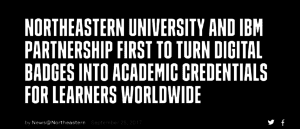How to Increase Adult Student Enrollment Through Organizational Partnerships
This article offers a comprehensive guide detailing why organizational partnerships are necessary to increase and sustain adult student enrollment for your programs and how you can begin implementing them today.
Below is a breakdown of the 12 major sections of the guide, each covering an important aspect related to increasing adult student enrollment through organizational partnerships.
Why Forge Organizational Partnerships to Increase Adult Student Enrollment?
Identifying the Right Organizations to Increase Adult Student Enrollment
Using Established Connections to Grow Organizational Partnerships
Working with Campus Stakeholders to Form Partnerships
Pitching Organizations with a Partnership to Increase Adult Student Enrollment
Breaking Down the Two Main Options for Partnering with Organizations
Providing One-off Educational Offerings Onsite at the Organization
Providing Degree and Certificate Programs Onsite at the Organization
Remaining Agile and Forward-Thinking
Being Honest About Your Institution’s Limitations
Building a Team to Grow Partnerships and Increase Adult Student Enrollment
Investing in Organizational Partnerships as a Priority
Why Forge Organizational Partnerships to Increase Adult Student Enrollment?
The shifting landscape of today’s workforce means universities and colleges must continue to adapt to meet the complex needs of more and more adult students—those who do not fall within the traditional 18-22-year-age range—with relevant and innovative degree programs, credentials, certificates, and other educational offerings. While adult students include those enrolled in master’s, doctorate, and continuing education programs, they also make up those enrolled in non-traditional bachelor degree completion programs.
Of this latter degree type, there has been tremendous growth in the number of prospective and current students. In fact, the majority of students seeking a bachelor’s degree are considered adult students. And that’s likely to be the case from now on, as the workforce increasingly favors individuals with the skills and expertise acquired from earning a bachelor’s degree.
There are a number of ways to increase adult student enrollment using traditional marketing strategies but, for many schools, these strategies alone no longer suffice. The market is saturated with adult programs, meaning that higher ed institutions with the strongest brand names and the most money to spend on advertising have the greatest advantage. This leaves smaller schools vying for scraps.
[bsa_pro_ad_space id=10]
However, some forward-thinking and innovative schools have begun to attract and acquire these coveted adult students with the help of a critical and successful strategy. This strategy entails forming partnerships with third-party organizations—businesses, nonprofits, government agencies, hospitals, and more—and offering programs tailored specifically for them.
 The decision to offer curricula on site at these partner organizations can increase adult student enrollment, expand the reach of your brand and programs, and bring massive revenue to your institution.
The decision to offer curricula on site at these partner organizations can increase adult student enrollment, expand the reach of your brand and programs, and bring massive revenue to your institution.
Likewise, it can help organizations attract and retain talented and committed employees to address the modern challenges facing their industries. And, of course, it can serve adult students, helping them acquire more education in order to widen their professional opportunities and reach their career goals. In other words, an organizational partnership is a win-win-win situation for your school, third-party organizations, and students.
Yet forging organizational partnerships is an opportunity of which many schools are not taking advantage. The Georgetown University Center on Education estimates that colleges and universities are missing out on a share of $772 billion, which is roughly the amount the U.S. spends on postsecondary education and training each year.
This indicates that organizations are willing to pay a hefty price for educational opportunities. This should be no surprise as organizations come to realize the host of costs associated with not properly responding to employees’ various needs—needs that include employee education and engagement. A Gallup report cites:
“…lack of employee engagement costs American businesses anywhere from $450 billion to $550 billion a year when workplace accidents, absenteeism and larger health care costs are included. The same principle goes for employees’ relationships with their employers. Nearly $11 billion is lost due to annual employee turnover.”
Losses like these have made organizations look for ways to educate and engage their employees. Organizations need employees who are well educated, creative and critical thinkers, and strong leaders.
This is good news for higher ed institutions. With many schools’ need to increase adult student enrollment in order to avoid shutting their doors, it’s necessary that they forge organizational partnerships to increase adult student enrollment.
Looking to increase adult student enrollment?
[bsa_pro_ad_space id=9]
Identifying the Right Organizations to Increase Adult Student Enrollment
It’s important to be clear about the right type of organizations with which to form partnerships. Obviously, this will have to do with the type of adult programs your school can offer. For a business-oriented degree completion program or MBA program, you’ll mainly be concerned with local businesses related specifically to the type of expertise your school provides. If you have a Supply Chain and Logistics concentration, for example, then it will be more effective to hone in on organizations that are in need of that business-related expertise.
It’s much more compelling to pitch an MBA program that is specifically designed to meet a certain skill set, such as logistics, sports marketing, or healthcare management, than a general, catch-all degree. Of course, for an RN to BSN program or a master’s in Public Health program, you’ll consider hospitals and other healthcare facilities.
Only seek organizations with which you can actually offer something of value. Simply telling these organizations you are going to offer their employees a degree that gives them “valuable skills” without detailing how they are relevant will not be as effective.
Kathryn Hutchinson, Ph.D., is VP of the Division of Student Affairs at St. John’s University. Eight years ago, she helped revamp its University Career Services Center in order to better serve traditional undergraduate students.
The result was an increase from an 80 percent graduate placement rate to an over 94 percent graduate placement rate. This rate has held steady over the last five years. While her experience relates to serving traditional students, St. John’s strategy to align with third-party organizational partners works for adult students as well.
Using Established Connections to Grow Organizational Partnerships
Hutchinson advises that you start with individuals at your institution who already have informal connections.
“We did a wide university outreach to see who already had partnerships with local organizations,” Hutchinson shared. “There are a lot of faculty and administrators across campuses who have their own informal relationships happening. They just don’t have a formalized process yet.”
Hutchinson understood that there are faculty on every campus with strong professional connections. Her plan? Go after this low-hanging fruit initially. She cited the example of a professor at St. John’s in the Communication department who had relationships with professionals at CBS and NBC.
But Hutchinson notes that it isn’t about taking over these relationships. It’s about supporting the individual with the connections.
 “We partnered with those across campus with industry contacts and rather than worrying about who owned the contact we focused on developing a trusting relationship,” Hutchinson said. “The goal of the partnerships on campus was to assist the community and bring more opportunities to students. We engaged the community in working on enhancing these connections.”
“We partnered with those across campus with industry contacts and rather than worrying about who owned the contact we focused on developing a trusting relationship,” Hutchinson said. “The goal of the partnerships on campus was to assist the community and bring more opportunities to students. We engaged the community in working on enhancing these connections.”
Understandably so, faculty and others across campus are going to be protective of the relationships they have. That’s why it’s important to honor those relationships by making it clear that you want to support them. You don’t want to commandeer their connections.
Hutchinson and the team has had success in the long run because they were able to help faculty and others understand the goal. And the goal was to increase the benefits of their connections to more students beyond the handful of students whom the faculty or staff member knows.
“We wanted to make it scalable since we have a lot of students. It was a very delicate balance and it took some time for individuals to trust us. But because we didn’t try to usurp or go around those relationships but augment them, we were able to make scalable the benefits of these connections, ones that still exist today along with literally hundreds more,” Hutchinson said.
The same approach should be taken to increase adult student enrollment. If an adjunct faculty member is also a nurse practitioner at a major nearby hospital and you’re looking to support your pipeline for your RN to BSN degree completion program, or if an MBA accounting professor is a consultant for a local business and you are looking to support your finance certificate program, then it’s much more effective to collaborate with these members of your institution who already have their foot in the door.
This relates to another effective approach to consider. Reach out to your school’s alumni and donors who are already connected to relevant organizations. Hutchinson also employed this strategy at St. John’s.
“Once we identified what organizations we were going to go after, we worked with the Alumni Relations Office and the Office of Institutional Advancement to find out if they had contacts in those organizations,” Hutchinson said. “We found our connectors, and with some of the larger organizations we were trying to find connectors at the highest level. Then we could reach out to these individuals and talk about what we were offering and how we want to partner and they were really excited about it. We looked for champions inside the places we were trying to partner with.”
Working with Campus Stakeholders to Form Partnerships
It’s much easier to begin a partnership by way of an alum or someone otherwise associated with your institution than it is to contact someone with no connection at all. Better yet, it is more effective to collaborate with individuals at your institution who regularly work with the contacts you’re pursuing.
It might be better to have an advancement officer introduce you to their contact to ensure all departments across campus are comfortable with and aware of the school’s multi-faceted engagement efforts with a particular donor or alum. Not only could it create friction between departments to go around the individual’s primary school contact, but it might also harm your institution’s relationship with the individual altogether.
The individual might not take kindly to being contacted by unfamiliar staff without notice from their primary school contact. Make sure you and anyone else involved with a given donor or alum are all on the same page with how you plan to approach them.
Of course, it’s often necessary to reach out to organizations with whom you have no prior contacts. While this might be more difficult since you won’t have an immediate in, you could find great success with a compelling case for how you and your institution conduct business with corporate partners to increase adult student enrollment.
Hutchinson clarifies that it’s imperative to have an organized process for communicating with organizations. She and her team found in a survey that a lack of streamlined communication was one of the primary obstacles organizations identified from their work with higher ed institutions.
That might come in the form of not having a regular contact at the school to serve as a consistent and dependable liaison, a lack of responsiveness from the school, the tendency not to follow up promptly, and so on. The best organizations prize efficiency and professionalism and seek relationships with other institutions that do so also. They want to partner with institutions that are prompt, professional, and open to collaboration.
Looking to increase adult student enrollment?
[bsa_pro_ad_space id=9]
“What we learned was that when trying to partner with professionals outside the university, too often universities focus on asking industry professionals for what they need.” Hutchinson explained, “It has to be a mutually beneficial relationship. As universities we need to show how it’s a mutually beneficial relationship and then act on it. The business world expects you to act. When they see that the school is efficient, easy to work with, and delivers they will want to align themselves with that institution.”
This aligns with a similar findings detailed in an article from The EvoLLLution:
“Corporations express concern over the responsiveness, agility and relevance of university-based providers. Universities need to be cognizant of and successfully manage these perceptions, whether the perceptions are based in the reality of a previously negative experience with another institution or are merely based on a lack of awareness.”
Pitching Organizations with a Partnership to Increase Adult Student Enrollment
Once you do finally get into a room with people from a given organization, be that through leveraging faculty or alumni connections or reaching out cold, it’s time to pitch how your institution can help them. For those looking to build pipelines to increase adult student enrollment, it’s critical to explain clearly what’s in it for the organization.
Christine Carpenter is the VP for Member Engagement at the Council for Adult Experiential Learning (CAEL), where she has worked for ten years linking learning to the workplace for the adult learner, and the Director of the Director of Energy Providers Coalition for Education (EPCE). She is quite familiar with the world of employer education initiatives and programs. And she can’t stress enough how important it is to make clear what the benefit to the employer would be in forming a university partnership.
“Schools really need to offer a solution for employers with their curricula,” Carpenter shared. “There are a lot of great colleges with a lot of great curricula, but they need to be geared toward employees gaining the competency and the skills that the employer is looking for.”
Carpenter clarifies that it’s not enough to assume that employers will see the inherent value in a bachelor’s or master’s degree simply because it’s a college degree. The programs need to address specific organizational and workforce development needs.
Higher ed institutions need to be able to explain why a digital marketing certificate or a degree completion program in organizational leadership on site will offer employees skills that specifically address employer’s workforce needs and problems.
“A return on education as a benefit is important to employers. Especially in the case when employers align their employee benefits with education tuition assistance programs, it becomes an ROI perspective. Companies and employers want a strong return on an education investment. When companies support and/or pay for ‘X’ degree it’s important to correlate it to ‘Y’ dollars saved, some definite type of employee retention improvement, or other important value for the company,” Carpenter explained.
Brandman University is an institution that understands this well. On its website are statistics, testimonials, and information for each organizational type (business, government, healthcare, and education), as well as clear calls-to-action to help explain the value of strategic partnerships for both their employees and organizational goals. This demonstrates that the university understands the needs and concerns of potential organizations and its willingness to collaborate closely with them.

Ruben Abarca has over ten years of experience in higher education working with corporate partners to increase adult student enrollment. His expertise and experience in this important and critical space within higher ed has led him to start his own consultancy company called Corporate Education Partners, Inc.
He explains the need for universities to clearly articulate why it’s important for potential partners not only to educate their workers, but also to rely on a school’s given resources.
“We explain how organizations need to do a better job of attracting Millennial talent or of retaining these folks, because every two years they are bouncing to another company. We would present a lot of research, being able to point them to this Deloitte study or that Mackenzie study, and explain that their employees want more than ping pong tables. They are looking for constant learning opportunities and growth,” Abarca shared. “We would also highlight studies that revealed that tuition reimbursement was the second most important benefit right after a 401(k).”
Abarca explained that while many organizations need more employees who think critically and are adaptable in the high-paced world of work, the best solution is to invest in the talent currently on hand, giving them opportunities to learn and grow along with the demands of the marketplace.
Not only would this make their organizations much more efficient, but it would save money as it fosters employee loyalty. Higher ed institutions must therefore prepare to sell potential relationships in a well-researched and compelling manner.
Download the guide below for an actionable checklist so you can start increasing adult student enrollment through organizational partnerships today!
Breaking Down the Two Main Options for Partnering with Organizations
Once you have identified the right organizations, convinced them of the benefit of your institution’s adult programs, and are ready to implement them, you can consider two main options. The most common partnership offering to increase adult student enrollment is a tuition discount or scholarship to the organization’s employees. That is sure to appeal, but you can garner even more interest with the second option: on-site curricula.
It’s this second option that has tremendous potential for helping you build your adult student enrollment. You can offer free presentations, workshops, or one-day courses at the organization itself. These entail having faculty or staff lecture or facilitate a discussion on some relevant topic. Better yet, you could create a short bootcamp, certificate, or credential program (though no longer for free). Or you can offer full programs, such as a bachelor degree completion or graduate degree program, on site and for a discounted rate.
Abarca unpacks the two major types of partnerships from his experience implementing them at DePaul University.
“The first one is a general partnership, which offers a standard discount to employees to enroll in our university’s programs. In our case we offered 10 percent on most programs,” Abarca explained. “The second type of programs are teach-on-site cohort programs. At DePaul, we would teach an entire MBA program, or whatever program they were looking for, bringing our professors out to the organization to regularly teach. We offered a larger discount for these programs, up to 25 percent off the cost of tuition. We also offered additional perks, such as a streamlined application process and dedicated advisors to walk alongside employee applicants. We launched 26 or 27 of these programs. 70 percent of them were MBA programs, the rest included bachelor completion programs, a doctorate, a master’s in Public Health, and so on.”
Since the standard reimbursement amount granted to employees by organizations is $5,250 (due to the fact that anything above that amount is taxable income), Abarca worked with organizations to help employees get the maximum benefit with a strategic, structured program. This program was in accordance with both the academic year as well as the tuition reimbursement schedule, which resets every calendar year. Although this required working with each organization and program on a case-by-case basis, the more they could make the program worthwhile for the student, organization, and the university, the better.
As far as curricula at the organization’s location is concerned, options include both free, one-off workshops as well as cohort programs.

Providing One-off Educational Offerings Onsite at the Organization
The free, one-off lecture presentation or workshop can be effective in getting your school’s name out there and acquiring a pool of prospective adult students to whom you can later market to increase your adult student enrollment. Can your school put together a presentation on techniques for managing others for lead nurses at a hospital? Can your school conduct a workshop on the profile of Gen-We for a group of sales and marketing employees?
This is where you can leverage the expertise of your university to provide value to your organizational partner. The benefits are that you’re able to obtain contact info for those who attend these free, on-site offerings and add them to a lead-nurturing campaign for appropriate degree programs, certificates, and credentials. It also helps with branding, fostering word-of-mouth marketing for a relatively low financial cost.
Compared to launching a full program, the financial and resource requirements are quite low. However, these on-site offerings still require some planning, coordination, and effort. It can be challenging to find professors who are willing to give a two-hour lecture for free. And the truth is that not all professors make the best teachers or lecturers when it comes to the corporate setting.
DePaul developed a vetting process to ensure that participating professors would be a good fit. Initially, Abarca or other members of the development team would give the presentations or lectures themselves. Word at DePaul eventually spread, however, and professors soon realized that participating would come with many benefits. These benefits included additional speaking or teaching engagements for pay by the organization. As the program became successful, one of the colleges was eventually able to offer honorariums for professors willing to participate.
This strategy is essentially a complex form of content marketing—offering free and valuable educational content to an organization in the hopes of being able to later market to participants and increase adult student enrollment.
“You are not just selling them something, now you are a content provider and you are an asset to them,” Abarca said.
Providing Degree and Certificate Programs Onsite at the Organization
The second strategy, offering degree programs, micro-credentials, certificates, and other longer-term programs on site for the organizational partner, is much more involved. It requires faculty who are willing to teach on site as well as a curriculum that is tailored to the organization’s needs. Abarca helped set DePaul up for success, building demand with an up to 25 percent discount and a minimum requirement of 20 students enrolled in order to launch a given cohort (though these cohorts usually started with around 35 students).
It’s also important to assist the organization with marketing the on-site programs to their employees. This includes offering them templated emails that they can send to employees or brochures and posters that can be placed in break rooms. The more buy-in you can generate from higher-ups who are willing to encourage their employees, the more employees will enroll.
[bsa_pro_ad_space id=10]
This is where, again, it’s necessary to build strong relationships with key organizational stakeholders and demonstrate prompt communication and follow-up.
Abarca touched on the pros and cons of offering both complimentary, one-off presentations and lectures and full, on-site cohort programs.
“By doing a one-off presentation or lecture, you are probably ultimately going to get several leads which may ultimately lead to one to two students,” Abarca said. “By offering cohort programs, you are getting a much larger number of paying students, though the downside is that these, especially with bachelor degree completion programs, require much more effort and coordination.”
Abarca elaborated on the difficulties of launching on-site bachelor degree completion programs to increase adult student enrollment.
“With those programs, you have adults all starting at different points. You have a couple of people who have no credits, some who already have an associate’s degree, and so on. So what we did was just offered certain classes that were required courses everybody had to take and we would cohort those. And then students would branch out and finish whatever they needed to finish through our school’s regular adult programs. We worked with students throughout the entire process to make sure they were completing their classes,” said Abarca.
Remaining Agile and Forward-Thinking
It’s critical that your institution is constantly re-evaluating the material being taught onsite in light of the organization’s shifting needs and industry-wide trends.
CAEL’s Carpenter honed in on this need for higher ed institutions to be more agile with their organizational offerings.
“It’s important for schools to stay abreast and in tune with these evolving workforce needs and make ongoing curricula updates while students are in the program. Otherwise students will complete the program years later and not have the most relevant skills needed in fast-changing industries,” Carpenter said.
 Northeastern University stands as a great example of a school that is adapting quickly to address the needs of their organizational partners. Due to its partnership with IBM, the university now recognizes IBM digital badge credentials (which the company gives out to its employees) toward graduate degree programs and certificates at the university.
Northeastern University stands as a great example of a school that is adapting quickly to address the needs of their organizational partners. Due to its partnership with IBM, the university now recognizes IBM digital badge credentials (which the company gives out to its employees) toward graduate degree programs and certificates at the university.
It’s a great strategy to encourage IBM employees to consider enrolling in a credential or graduate program at the university (thereby increasing adult student enrollment). These already-earned Northeastern credits will make employees more inclined to finish a program more quickly and for less money than they would at another university.
Hutchinson provided another example from her team’s work at St. John’s. The school’s relationship with ESPN enabled them to discover that the famous sports media company was struggling to find individuals with the necessary skill set in sports analytics.
Learning of this need, they began collaborating with members of ESPN and faculty from the sports management, marketing, and mathematics departments on campus to develop a program that could fit this emerging industry trend.
“What ended up happening as a result of this collaboration was that we changed the curriculum. And now we have a course in sports analytics. One member of our faculty even started a sports analytics and management club on campus. We discussed what changes needed to be made in the spring and had a sports analytics class on the books in the fall,” Hutchinson shared.
Abarca understood this need to adapt as well, recognizing a trend among some employee students. Abarca and the DePaul team noticed that some adult students were dropping out of the MBA on-site cohorts for some reason. After they did some digging, they found out these students were re-enrolling in DePaul’s part-time MBA program instead of continuing with the cohort model on site.
“They were doing this because they wanted to choose their own electives, so they were dropping out of the cohort to enroll into the part-time program to take what they perceived to be more relevant classes,” Abarca said.
The solution they came up with was to restructure the MBA cohort model. After taking a certain number of classes with employee peers on site, students would then take a few elective courses at the university (whether on site at DePaul or online) before coming back to the original on-site cohort for a final, concluding course.
This maintained the camaraderie of the original cohort. It kept it intact while also allowing students to take courses that were more relevant to them, such as in finance or marketing. It also allowed students to meet others outside of their organization. This allowed possibility for networking opportunities and exposure to what other companies and industries were doing.
Once you get these on-site programs rolling it’s necessary to continue to evaluate if they are meeting both organizations’ and students’ needs in an ever-changing and highly competitive marketplace.
This ensures that organizations will continue to see the value in such partnerships and help grow your school’s programs across even more organizations (because the word-of-mouth marketing from your partner organizations can pay off tremendously). And your ability to cite a history of quick adaptations will make it easier to convince even more potential stakeholders to form a relationship.
Being Honest About Your Institution’s Limitations
It’s impossible to support every single organization and address every industry’s needs. Instead, it’s worth it to increase adult student enrollment through programs that are sustainable: ones that play to your school’s strengths. It only damages your school and its brand by trying to launch programs for which you don’t have the faculty expertise or long-term support.
Carpenter suggested partnering with other local universities to understand how every school can work together to support the more-than-enough organizations in a given community. It can be ill-advised for a school to try and compete unnecessarily with another school.
For example, a university with tremendous medical resources and expertise might not be worth going head-to-head with in your community’s healthcare sector when there is an opportunity to work with nonprofit or governmental organizations that your school is better equipped to support.
“Sustainability around all of these types of strategic partnerships is important,” Carpenter said. “The idea that a single school can be everything to everybody does not work. It’s okay to look around and see which schools are doing certain programs better than you can, and then thinking through how you can partner with them or how you can pivot and get involved somewhere else where you might have better resources to do it longer.”
Building a Team to Grow Partnerships and Increase Adult Student Enrollment
Of course, developing a coherent strategy to manage these partnerships is not a small investment. It’s important that a team is hired and dedicated as much as possible to the purpose of forging, managing, and evaluating these organizational partnerships. Asking a team of faculty or adult program admissions counselors to take on this responsibility simply “when they can” is not feasible. A real investment in this kind of strategy requires dedicated human resources to make it run effectively.
 “A lot of schools don’t know where to start. They don’t know what they have to build internally, and they think they can have their faculty reach out to corporate contacts but that’s not going to work. They need an intermediary between the organizations and the university,” Abarca advised. “Number one, I would say a school needs to build a corporate outreach team, which is going to be the most successful thing to do.”
“A lot of schools don’t know where to start. They don’t know what they have to build internally, and they think they can have their faculty reach out to corporate contacts but that’s not going to work. They need an intermediary between the organizations and the university,” Abarca advised. “Number one, I would say a school needs to build a corporate outreach team, which is going to be the most successful thing to do.”
Reaching out to alumni and donors established at certain organizations, empowering and supporting faculty who already have strong organizational contacts, collaborating with organizations’ HR departments to develop program pricing structures, securing faculty to teach workshops or full cohort programs, advising employee students as they work through a given program—all this, and much more, can’t be accomplished without a team dedicated to these things.
Looking to increase adult student enrollment?
[bsa_pro_ad_space id=9]
The team doesn’t have to be large to start. A team of just a couple of people (or a third-party consultancy serving as your “off-site team”) can be much more effective than other departments tasked to take on these responsibilities in their “spare time.”
“There are multiple players that are doing it at the national level, but I think every higher ed institution has to look at themselves and say why don’t we at least try. I often ask universities, ‘What is holding you back?” Abarca continued. “People are comfortable with what they know. Universities, when they run into admissions issues, will follow the exact same steps that they’ve always done. They will start buying mass media and they will spend millions of dollars on radio and ads. There is nothing wrong with doing this because it helps build brand recognition in general in the marketplace, but that can’t be all they do.”
Investing in Organizational Partnerships as a Priority
Abarca can’t stress enough how successfully DePaul’s organizational partnerships were able to increase adult student enrollment.
“There is plenty of need in the marketplace for these types of partnerships. The universities that understand this and know how to implement it can do well. DePaul makes tens of millions of dollars on these programs,” Abarca said. “It was an extremely lucrative program for the university when I was there. I started my own firm, and I am now starting to help other institutions create a similar model.”
The bottom line is that it’s becoming increasingly difficult to support and increase adult student enrollment through traditional marketing and strategic efforts. And organizations are realizing that offering educational opportunities has tremendous benefits in creating and retaining employees who are motivated, knowledgeable, and ready to address the shifting landscape of industry needs.
The higher ed institutions that understand this huge opportunity and are willing to make the investment are the ones that will be set up for increasing revenue through greater adult student enrollment.




